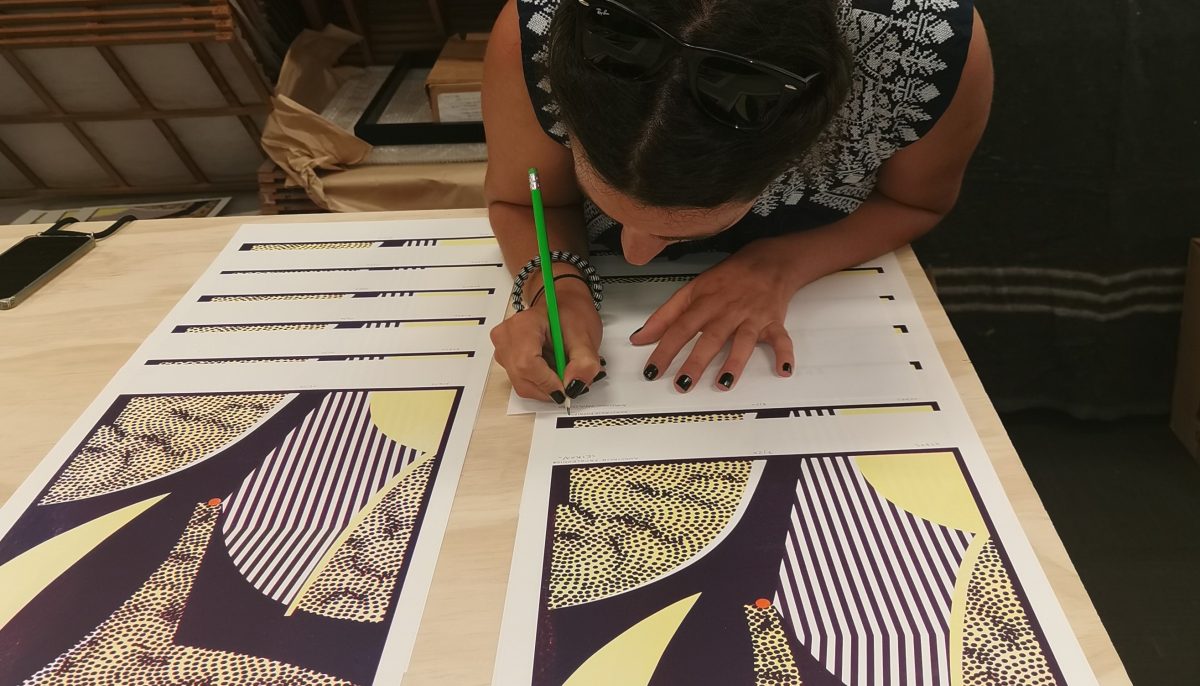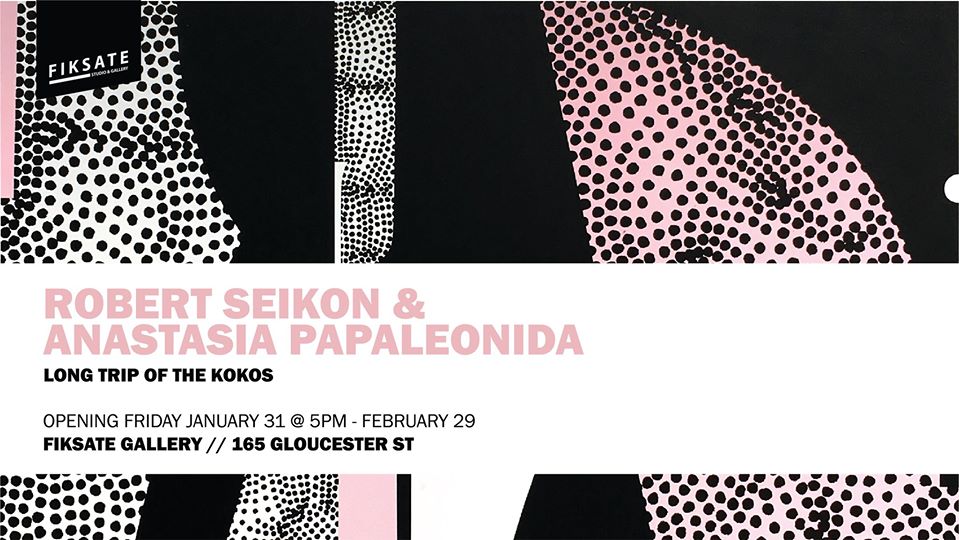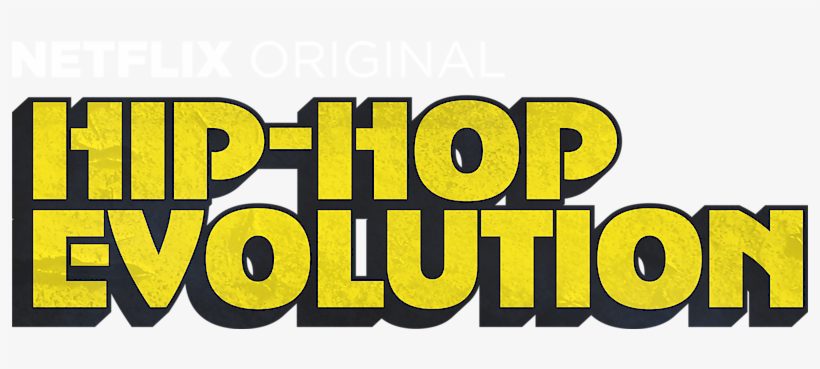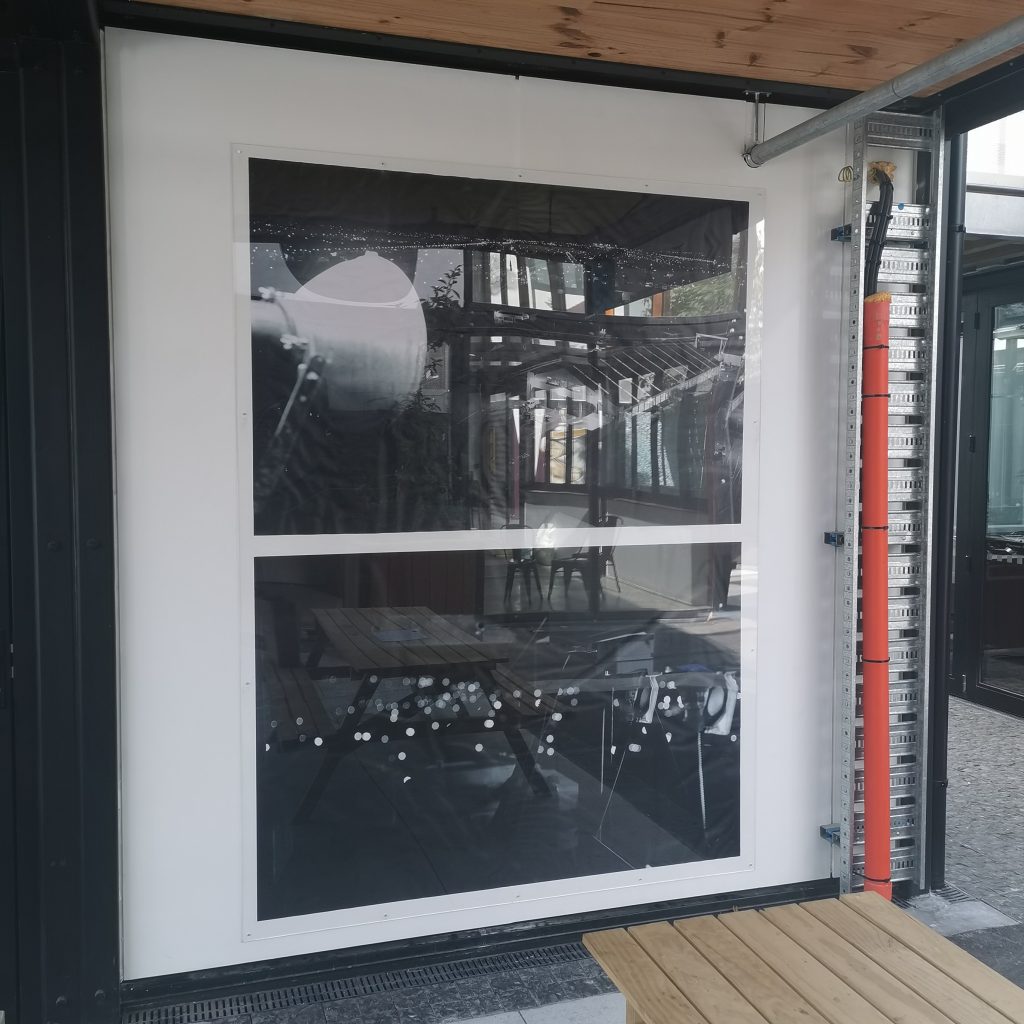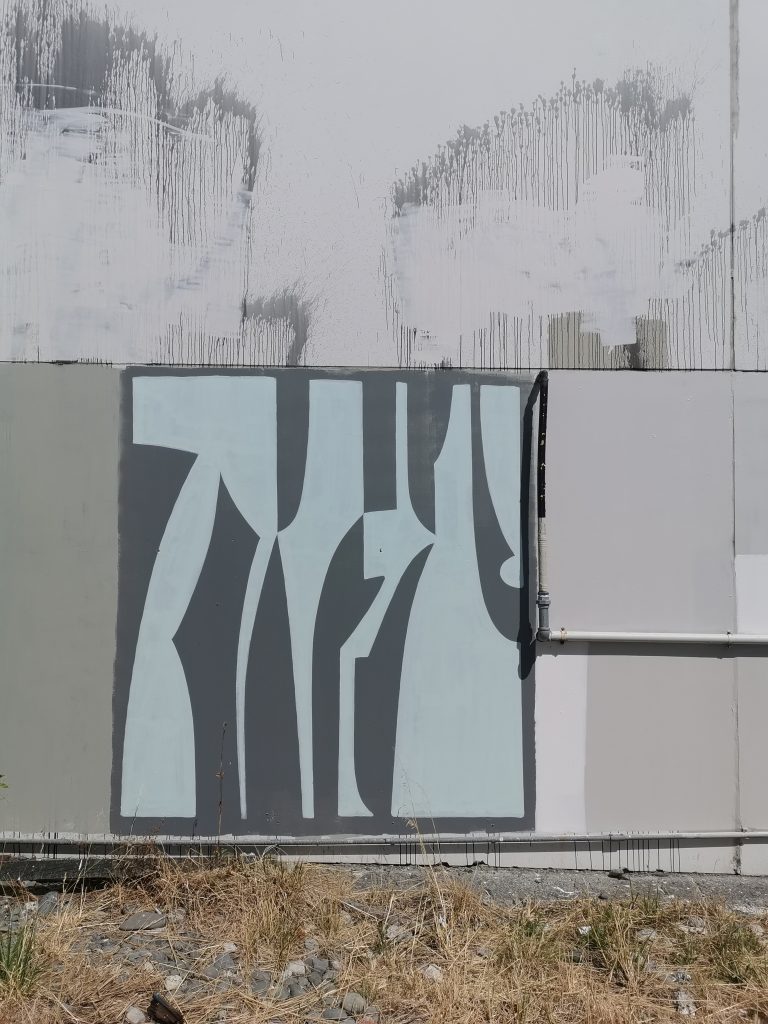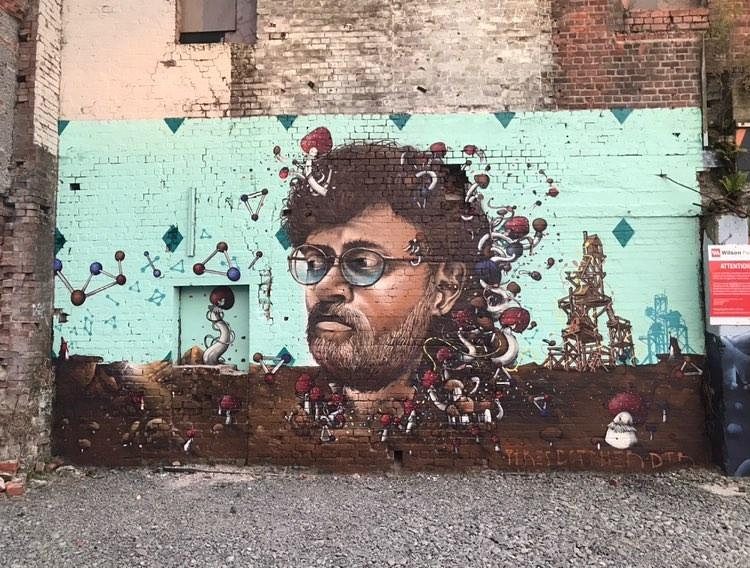For the month of January Fiksate became a second home for itinerant artists Robert Seikon and Anastasia Papaleonida, the gallery’s first international residents. While Seikon is Polish, the couple are based in Greece, Papaleonida’s home country. That international flavor is further enhanced by their travels, with their arrival in Aotearoa following a stay in the Philippines and an exhibition in Taiwan. During their residency, I was able to spend time with the endearing duo. It was fascinating watching the two, who have been working together for almost twelve months, operate in the studio, each maintaining their distinct stylistic identity, while investigating the potential of collaboration. The artists alternate between a hyper-focus on their individual contributions and conferences around subtle details of composition and colour. But it is not just the studio where their collaborations flourish, with their work appearing on walls in numerous locations, including a number of works produced during their stay in Christchurch. While Seikon’s background in graffiti provides a lineage for this public practice, Papaleonida is relatively new to this approach, coming from a design foundation, bringing a unique consideration to their creative process. Their pairing has resulted in visually stunning works, where sharp, angular aspects contrast with organic elements, creating optical effects that invite the viewer to immerse themselves in the image, only to discover small, unsettling details that disrupt expectation, rewarding inspection. We caught up with Robert and Anastasia as their exhibition Long Trip of the Kokos drew near, taking in the sights and delights of Lyttelton, sitting down for a discussion about their experiences in Christchurch and New Zealand, their collaborative partnership and the differences working indoors and outside…
Welcome to Aotearoa! How long have you been in the country now?
RS: We have been here for one month already. It’s very nice.
AP: Amazing.
What are your perceptions of New Zealand so far?
AP: Everything is very organized and super clean! You are in the middle of nowhere and there’s a bathroom with a paper, it’s like, what the fuck?! And in general, the people are super nice.
RS: It’s not only the toilets that are clean! The grass is cut everywhere, fresh walls are repainted, everything is clean. You get the feeling you are at the end of the world, that you are very far away. But everyone is super friendly, you feel comfortable as soon as you get out of the airport.
As artists, do the distinct atmospheres of different cities and countries start to influence your work?
RS: It makes a difference for sure. Here for example, during our trip from the North Island to the South Island, the landscape was changing almost every hour. The landscapes in New Zealand combine parts of European landscapes all together, which is very interesting for us. All the colors and shapes we have seen during this trip have made a big impact on us.
Both of you work in abstraction. What specific influences have fed into the recurring motifs in your work? Have they come from real world references?
AP: For me, it’s about landscapes, plants, organic things…
RS: For me it is both the natural landscape and the urban environment. But in this case, for this exhibition, I think mostly the landscape, because we have worked with the memories that we have collected over the last few weeks of being in New Zealand. Sometimes I like to be inspired by the city, but here it hasn’t been the case. If we work with a wall in the city, the surrounding area is going to inspire the wall, but for this exhibition the influence is mostly the natural landscape.
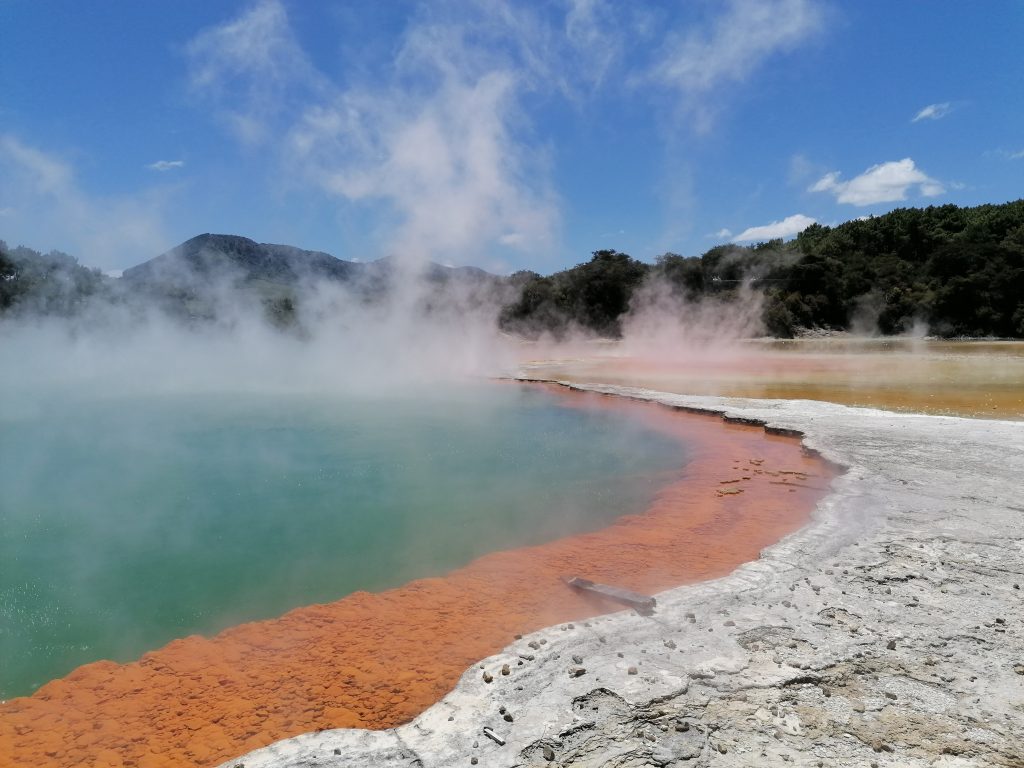
There is an interesting interplay between your individual approaches; Anastasia, your more organic forms that seem to reference the cellular and biological, while Robert, your lines and geometric forms seem more hard-edged. While those aspects are quite distinct, the colors seem much more of a collaborative component…
RS: We enjoy talking about color.
AP: Yes, on this trip we have worked a lot more with color. In the past we didn’t have the opportunity to do that much, we were working a lot with black and white.
RS: In general, we like to use black and white.
AP: But, after this trip, travelling in the Philippines and here, the colors we have seen have been amazing and we have started to mix more colours. With all the work we have prepared for this exhibition, we have mixed I don’t know how many colors…
RS: We haven’t used straight black like we have before. Everything is mixed with something…
AP: The vision that we have for the exhibition is to create an atmosphere that is unique, which comes through not using straight black like we have in the past.

This body of work has been created as part of your residency at Fiksate. You have noted the influence of your travels, but did you already have an idea of the work you were going to make when you arrived in Christchurch, or has the experience of the residency, the place and people, inspired the works as well?
AP: It has been interesting to work with other people around. For me, often when I’m working on something new, it takes time before I realize that something is happening for a particular reason. I can’t always see it at the time, but when I look back I can see that it came from somewhere…
I’ve noticed that your shared work station is very organized, from paint cups numbered in a spectrum of tints, to the way tools are laid out, is that something that has developed as part of your working relationship, or was it always evident individually?
RS: I think that is something we’ve both had from the past. Me, I always like to be precise and clean. We don’t even talk about it. We’ve got the same thinking in common…
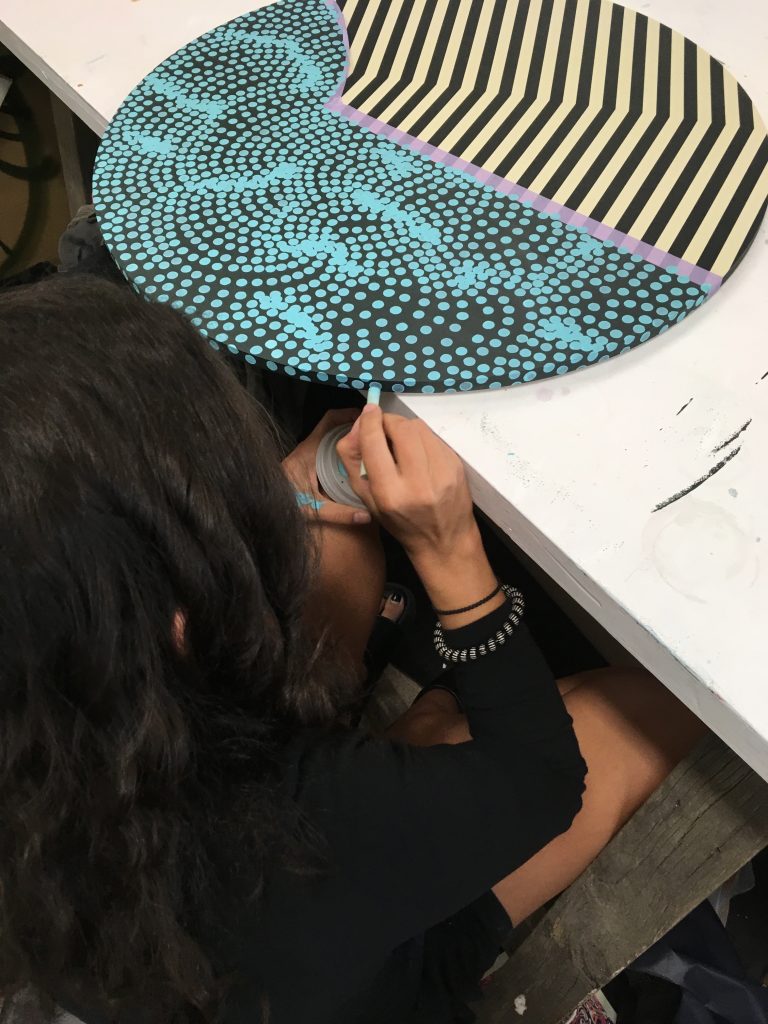
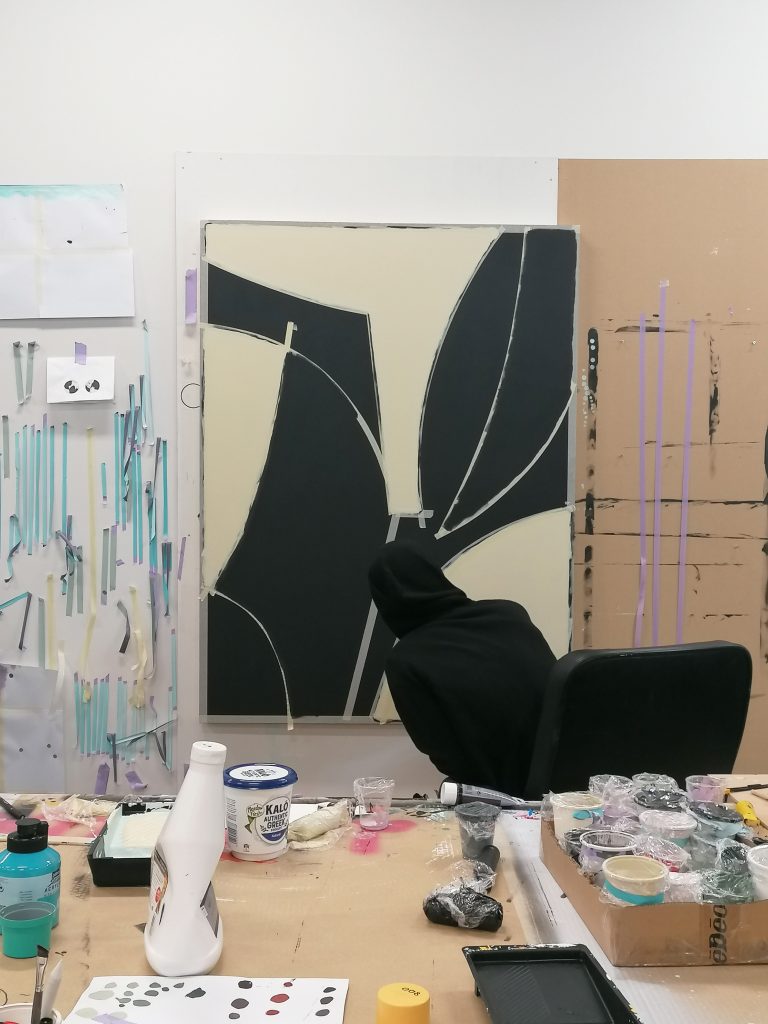
Is that sense of order intrinsically necessary to make the work look the way it does, or is it just a comforting aspect? I’m sure you are both very particular about the clean lines, the perfect dots, the sharp shapes and the smooth gradients, so that organisation must be important in achieving those effects, right? In the studio you can control those elements a little bit more, but do you have the same level of preparedness and organization when you’re painting outdoors?
RS: Oh yes, I like to prepare my bag the day before, so I am ready to have breakfast and go. Then, the morning before painting, I check everything is in my bag; the roller, the sketchbook…
AP: You need this, you need this… Outdoors, it’s like a small studio because you are spending hours in that place and you need your stuff in specific places, so it is free for the wall and for your movements…
There is a physicality to the way each of you work, a physical activity that goes into creating the details, from precise movements to more sweeping gestures. I’ve noticed that when you are working in the studio, while there are times when you’re both working on the same piece, often one of you is active and the other is either observing or off to the side, is that simply to give each other the physical space for these movements?
AP: To be honest I haven’t thought about that before, but maybe, now that you’re saying it, it does work like that, because when someone wants to do something more precise, you need to give him the space to do it…
RS: It’s a good observation. When we work, for example when Anastasia is working and I’ve got a small break, I’m also thinking about the things that I will do next, I’m waiting for Anastasia to move so I can get another answer, you know? It’s like, this little bit here is developing, so what is going to happen next?
AP: It’s not like we are doing sketches and they are the final product. When we create something, we will always add something new, because that touch goes like that, or this line goes like this, and we look at the balance and realize that maybe something new needs to be done. I think this is very interesting because we don’t really know what the final image will be.
RS: We don’t really know what will happen.
AP: And you build that slowly with small moves, it becomes a surprise…
Anastasia, it feels like your dots would have a more spontaneous nature, while Robert, your diagonal lines would be more carefully planned and constructed. But, is that actually the case, or are you both more balanced in your approach?
RS: The biggest similarity we have is that when we are working, we are super focused. You go inside an element and nothing can disturb you. Both of us are very focused on the process of our work. I don’t know, even if the lines or the dots are repeated forms, they can be created from elements all around us, even though they are clean, they can be natural as well.
Your studio output will become the exhibition, Long Trip of the Kokos, but you will also paint several outdoor commissions as well, each in very different settings. Is it important to get out of the studio?
RS: We like to change the environment around us. After spending weeks preparing the exhibition, we have had enough of the studio. We couldn’t start next week again in the studio. I like to have a change when I’m painting, it’s refreshing.
AP: What we will do on these walls will be a continuation of the inspiration that we have drawn from already. Although, with the Cosmic wall [a commission at the warehouse of iconic funk store Cosmic], we will work with a lot of colours, which is something we haven’t done much together. That will be very interesting for us…

Do you ever reflect on being in the position where you can travel to places and leave something of a legacy through painting public works? Do they create a connection to place that average tourists don’t necessarily get?
AP: To be honest, I’m not thinking about that so much, that I will leave this wall as a legacy. It’s more about the process, the time that I’m spending doing it, the time that I’m painting, the people that are around, the interactions with people, the small talk, a question or a smile…
RS: And the moment you finish the artwork, that’s it. You are doing it until that final moment. I’m always crazy happy when I’m painting, when I’m doing something, then the moment I’m satisfied it’s finished, it is for other people from that point. I have made my thing, this is it. I’m very happy if someone gets positive vibes or can see something interesting, but I don’t need feedback. It’s all about the process, like Anastasia said, the process is going to stay in our memories.
The studio environment is secure, but also isolating, it is different from a public presence where those small conversations can more easily take place…
AP: It is very nice to have a connection with people, but also the work carries on, it is seen by people that you don’t meet, even if they don’t say anything, or they say or think something bad…
RS: But here we have been very surprised about how people have reacted to our art. We were traveling here without any expectations, we said: ‘let’s go to New Zealand and see what happens…’ But both of us are very surprised by how people have reacted…
In all of your travel, are there moments of engaging with people while working on a painting or mural that stand out?
RS: I mean, it doesn’t need to be anything special, it can just be small things, you know, you wake up and you see people and they’re happy in the morning…
AP: In Estonia, there was this old lady, every day she was coming and checking, without any expression. I mean every day, seven days we were there, and every day she checked with no expression. Then when we were finished, she finally said: ‘Yes, it’s nice.’
I wanted to ask about the title of the show Long Trip of the Kokos, what does it refer to?
RS: The story behind the title, comes from when we were in the Philippines. We saw a lot of kokos [coconuts] and they were traveling, somehow, they would go to the water, they were moved by the ocean, they would jump to the other islands. We thought maybe we are a little bit like these kokos, travelling and stopping here to make this small mark. This exhibition is the mark of these small travelers coming here to grow a little bit.
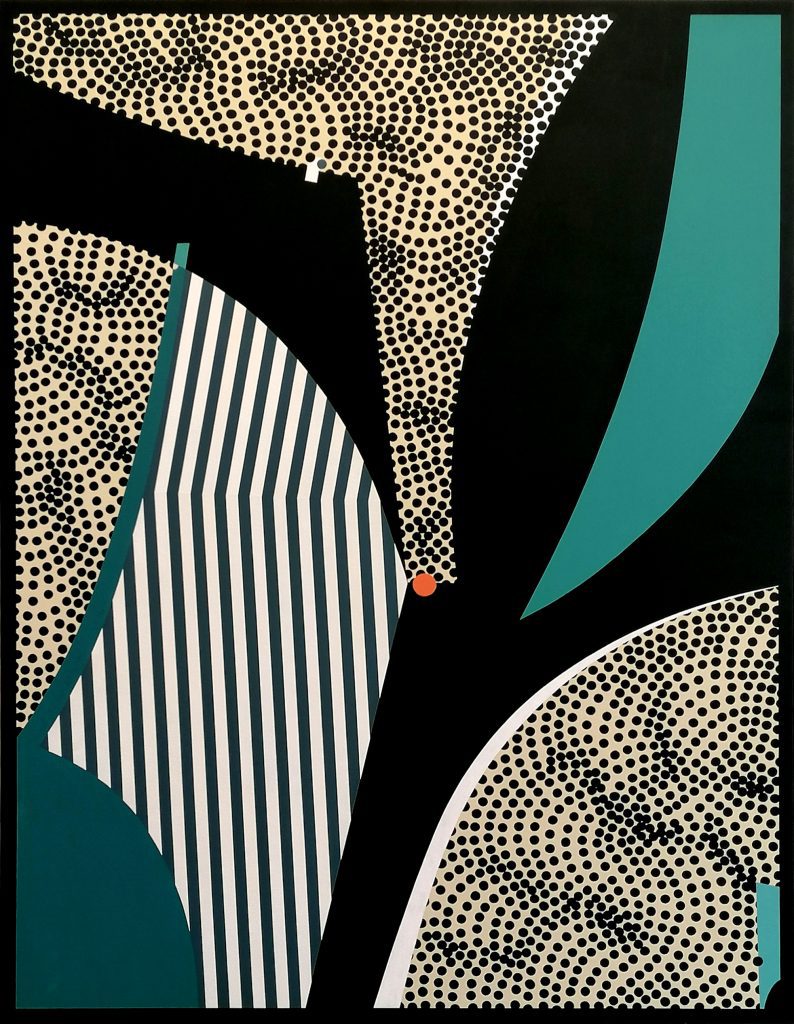
This is an audience that you haven’t really had much experience with, but based on what you’ve experienced so far at Fiksate, and the people who have come through, have you been able to get a gauge of what you might expect?
AP: You know, we don’t really know what is going to happen…
RS: We are not expecting anything, but we don’t really make work in that way.
AP: All the thinking was to make these works because of the inspiration this experience has given us. It isn’t about what we will sell, it’s more about what we would love to present.
RS: We like working in this very expressive way. We have thoughts. We start to talk about it. We have a conversation, and then we say: ‘OK, let’s do it, why not? Let’s see what will happen…’ We didn’t expect anything, but we have already very positive feedback.
AP: Yes, although I am still not sure about how the audience will respond to our point of view on abstract.
Right, abstraction has become more and more prevalent within both urban contemporary and mural practice, but New Zealand can lag behind in some trends. Fiksate recently staged their Urban Abstract show and that was perhaps quite new for a lot of the audience, who might have been more accustomed to letter forms, figurative stencils and illustrations, and representational murals…
AP: I was thinking about that, because in most of the cities we have visited, the murals are pretty figurative, abstraction doesn’t seem to be as popular.
RS: But the abstract things here are on a good level. Sculptures or installations, they seem to be in good taste, which we were happy to see.
Robert, you have investigated translating your work into sculptural forms, right?
RS: Yes but not a crazy big amount, I am just beginning to touch on this direction. I started some years ago. It is not super easy to do, but I want to keep going because it gives me different positive vibes…
It seems like more and more artists are translating their work in different ways, into objects, installations, using light, projections, etc. It seems that more doors are open for artists from the urban realm, due to the popularity and visibility of muralism. Anastasia, how do you think your work would translate into a three-dimensional, or kinetic form?
AP: I have worked with smaller forms of sculpture, but I am probably more interested in installations. I have a lot of ideas, and I’m going to keep going with other projects.
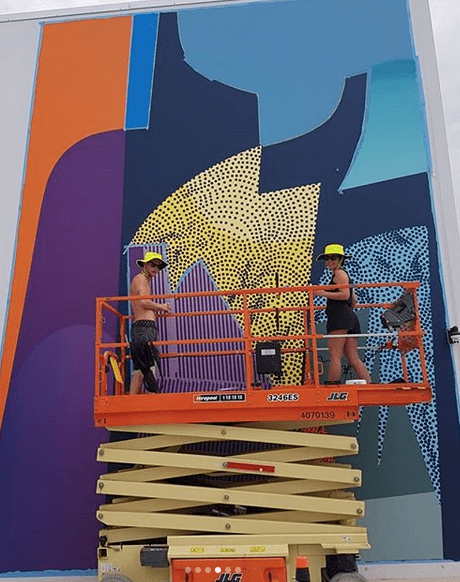
How do you operate in terms of having your own distinct paths as artists while still collaborating? Are you constantly working on your own things and then coming together for certain projects, or has it become more and more about the collaboration?
RS: We like to work in both ways, it depends of the project. Especially for this exhibition, it’s all about collaborative work. It’s nice for us to have the chance to involve our personal distinct paths and create something together.
AP: This is an interesting way to work because we have the opportunity for a dialogue.

It has only been just under a year that you’ve been working together…
AP: Almost a year.
That’s a relatively short time, so there is obviously a lot more to explore within your creative partnership. But long-term working partnerships can sometimes see the distinctions between each artist deteriorate, and a unified aesthetic develop, is that something you are consciously trying to avoid, or do you see it happening?
RS: That is a very open question, because already this year, new things have developed that can support our personal projects and we obviously have days when we want to create something by ourselves. The process is going here and the process is going there and we can mix those possibilities together. It’s super open for us.
What do you have planned for the rest of the year? When do you leave New Zealand?
RS: We leave on the 10th of February. We will go back home to Greece, and then we have something in Germany and a project in France, another project in Slovakia and that’s it for the moment. Maybe a small holiday after that…
It seems like travel is just an engrained part of the urban art movement…
RS: It’s not for everybody though. I’ve got artist friends who do not travel at all, they stay in the studio and that’s it.
AP: And for some artists it is not that important, I mean they feel better in their studio. It depends on the artist.
RS: For me, travel is the research about new places. From when I started painting, my city started to be like, OK, I’ve seen all the streets, all the nice places, I’ve painted here, I’ve painted there, but I need to search for more possibilities. I need to see different things that could inspire me, collect new knowledge and have that energy, this is important in my creative process.
How do you make your work resonate with different places? With abstraction, you aren’t using explicit cultural references, which can be a minefield anyway. Is your visual language such a personal reflection that it doesn’t necessarily need to display that connection to place in any overt way?
RS: I started to realize this a short time ago to be honest, I was traveling for many years and just reached a point where I’ve got things that I start to talk about and understand more. Now, I keep collecting those ideas as I travel, and they come out in my work.
AP: I think it’s important to observe what’s going on in any country because I don’t want to offend anyone. For example, in the Philippines, black is very bad. It’s the color of death. The associations of black mean you don’t use it. We tried to find it in the paint stores, but you couldn’t. When we went there, we didn’t realize how important it was to not use black, but we adapted over the month we were there and we started to realize more things that were important for people there, especially since we were painting a lot on small houses in the middle of the forest.
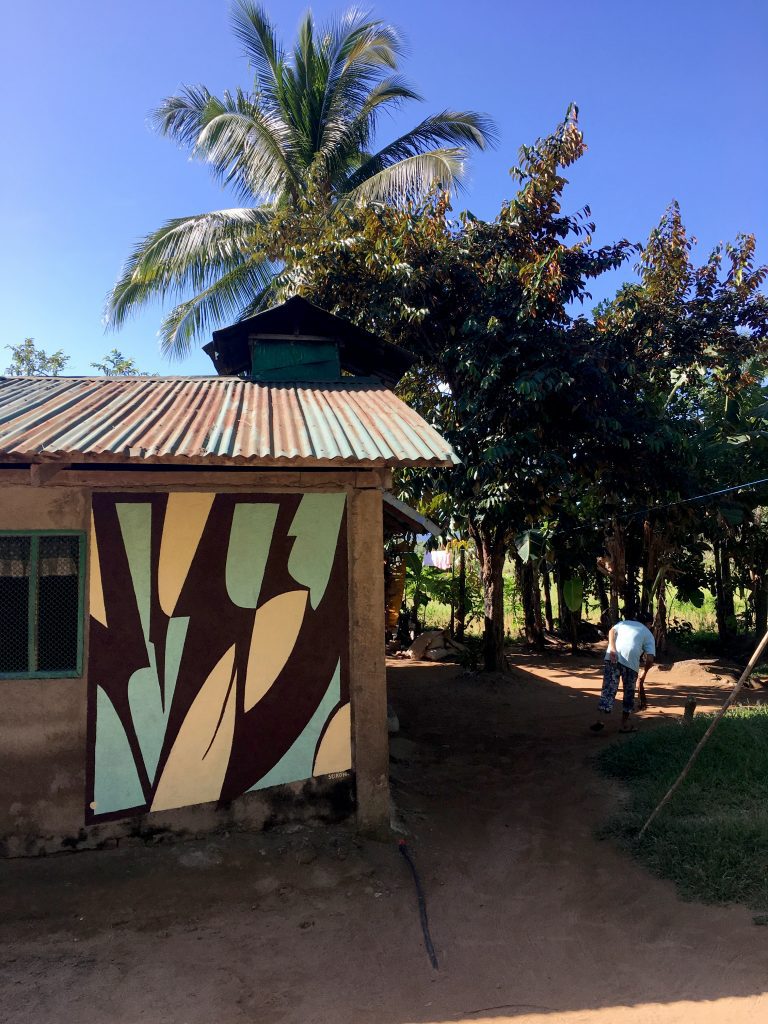
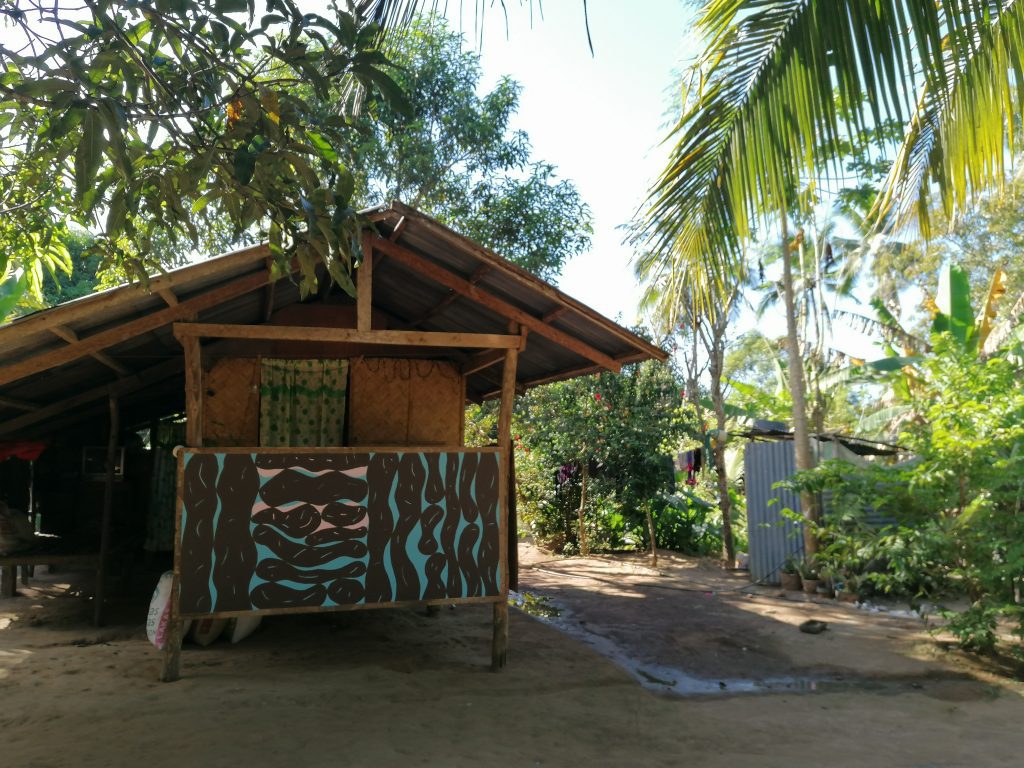
The chance to do research isn’t as easy for some artists, who might not have the luxury of a site visit or to acclimatize, especially if you are moving from job to job and have to hit the ground running in any new place you find yourself…
RS: The perfect situation is where you come to the place and you’ve got some time to prepare, not just going to a place with the sketch, painting it and leaving…
AP: Although it might not be possible, because if you do a big mural, you often need to give something to the people to see…
RS: Yes, but for us, we like to say, this is the sketch but by the end it is going to be a bit different…
Do you want to say thank you to anyone from your time in New Zealand?
AP & RS: Thank you to Fiksate Gallery for the trust and to all crazy positive people that we met during our stay in New Zealand…
Follow Seikon and Papaleonida online…
Long Trip of the Kokos runs until February 29th, 2020 at Fiksate Gallery, 165 Gloucester Street, Christchurch.

